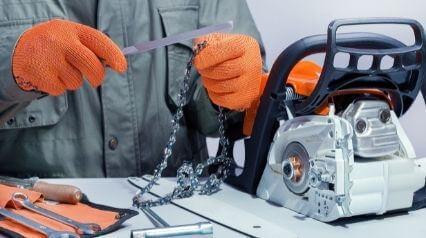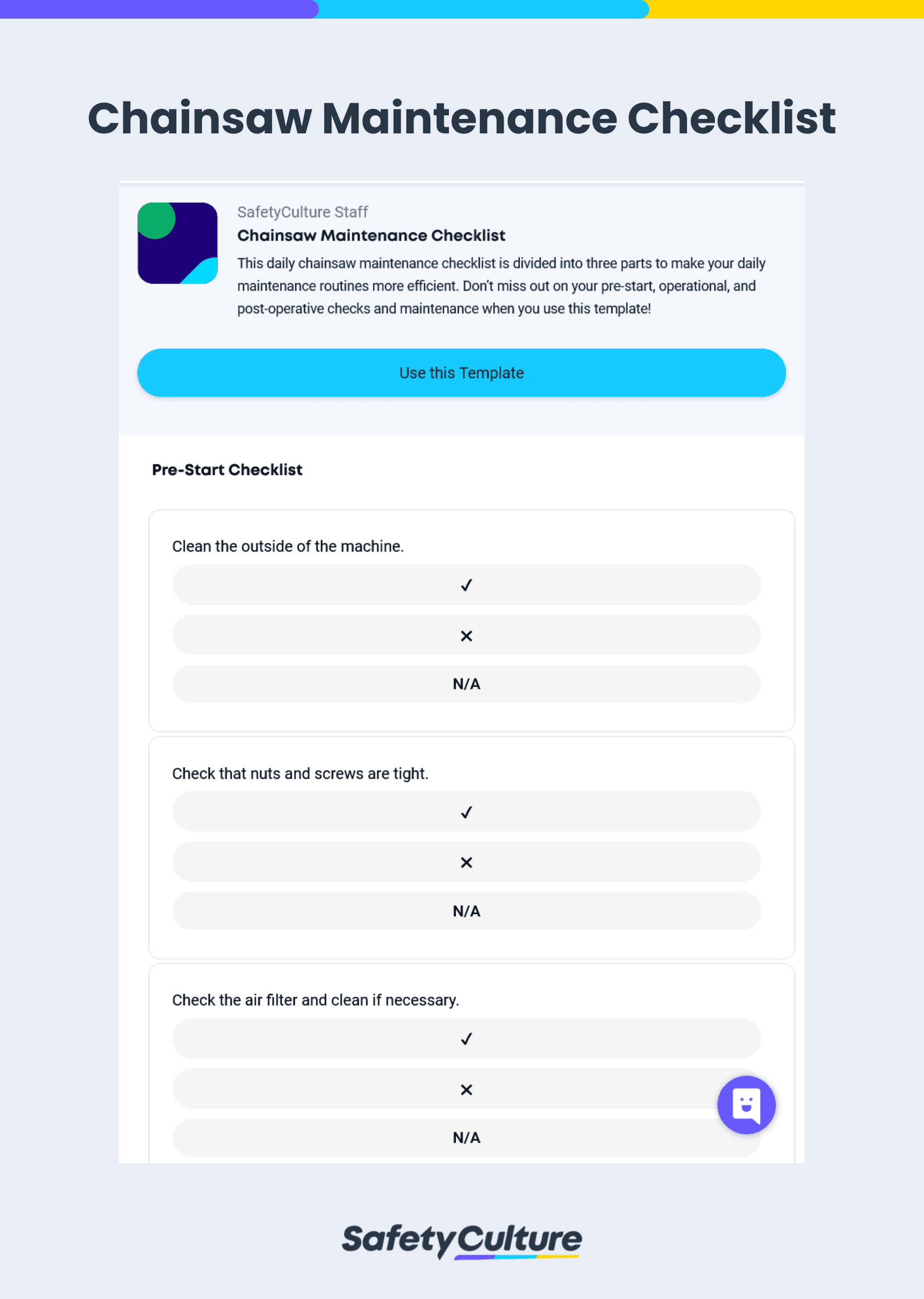What is Chainsaw Maintenance?
Chainsaw maintenance is the method of keeping your mechanical power tool in good running condition and extending its serviceable life. It is conducted by professional loggers, tree workers, arborists, farmers, millers, and other forestry workers with the help of a chainsaw maintenance checklist.
Organizations constantly working with forestry equipment like chainsaws and other hand and power tools should integrate manual handling risk assessments into their safety protocols, which should be carried out by health and safety officers on a regular basis.
Why is Chainsaw Maintenance Important?
Conducting regular chainsaw maintenance not only increases your tool’s sawing efficiency, but also reduces your risk of having injuries and accidents. It also prolongs the chainsaw’s life cycle and lets you save on repair and replacement costs.
If you intend to use a chainsaw on a daily basis, you must do small maintenance checks to avoid neglecting your machine. This is where a chainsaw maintenance checklist helps you get the job done.
Maintaining sharp chains helps prevent dangerous kickbacks. Apart from that, cutting with a dull or blunt chain leads to more time-consuming work with your chainsaw, which also yields higher fuel consumption and excessive wear.
Proactive Maintenance: Safety Tips
Apart from conducting your routine inspection using a chainsaw maintenance checklist, you also need to regularly maintain the components of a chainsaw. According to Total Landscape Care, these include the following:
- Engine – Maintains chain rotation at optimal speed through the use of gas or electricity
- Chain – Improves cutting performance and minimizes kickback using its teeth
- Chain brake – Reduces the risk of injury by stopping chain rotation when there is kickback
- Lubrication system – Prevents excess friction, heat, and stuttering during chain rotation
- Air filter – Stops engine from overheating due to overuse or irregular maintenance
Before starting your chainsaw maintenance and inspection routines, OSHA recommends doing the following:
- Checking all controls, bolts, and handles for possible safety risks
- Verifying the chain tension is adjusted based on the manufacturer’s guidelines
- Ensuring the fuel and lubrication systems are filled to recommended levels
- Putting on the correct chainsaw PPE such as safety glasses, work gloves, and hard hats among others
How to Take Care of a Chainsaw
Reducing potential harm while using your chainsaw is an integral benefit of properly taking care of it. Through the help of a chainsaw maintenance checklist, you can ensure you’re not missing anything during your inspection and maintenance routines.
Keeping it clean
As you keep using your chainsaw, the more likely it is for debris, such as sawdust, tree sap, and globs of oil, to accumulate on it. Keeping your chainsaw clean means you’ll need to know the right cleaning techniques to use for each part.
Checking it regularly
Maintain your chainsaw’s pristine condition by doing routine checks, such as:
- Checking the bar and chain oil level before each use
- Checking if the chain is sharp to not only make cutting more efficient, but also to prevent kickbacks and ensure your safety while using it
- Checking if there is no debris left after each use
Sharpening the chain
Avoid oversharpening your chain. You don’t necessarily need to sharpen it before each use, which can otherwise cause various problems and hazards. One example is that oversharpened chain teeth can bite too deeply into the wood, which may cause your tool to stall or pull you off balance as you’re working. Chainsaw experts such as professional woodsmen and carvers highly suggest sharpening your chain when you have to apply pressure when you’re cutting.
Investing in a round file with a file guide to sharpen the chain blades is a key part of your chainsaw maintenance checklist. A flat file with a depth-gauge guide, on the other hand, is best for lowering the depth gauges.
Use a bench vise to secure your saw while you’re working on it. Start by engaging the chain brake, then sharpen the cutting teeth. Position the file depth gauge on the chain in a way that arrows point toward the chainsaw bar nose. Next, begin filing at a right angle to the chainsaw rollers. Make sure to file every cutting tooth using a smooth and even pushing stroke. Afterward, turn the saw around so that it is facing the opposite direction. Lastly, finish filing the other cutting teeth using the same motion as before.
Filing the depth gauges
The depth gauges, located between the cutting teeth, must be filed every third time you file the cutting teeth. Put the file gauge over the depth gauge, then choose “hard” or “soft” depending on the type of wood you normally saw. Then, proceed to file the depth gauge until the file comes into contact with the file gauge.
Storing a chainsaw
You should also know how to store a chainsaw properly. Most manufacturers recommend draining the fuel and bar oil when you’re preparing the chainsaw for the winter. First, decant all the fuel and chain oil into clean containers, then run the engine until it stops. This will clear out any fuel in the fuel lines and carburetor. Afterward, use a clean rag to clean the fuel and oil tanks. Lastly, service and clean the chainsaw before storing it in a dry, neat place.
What is a Chainsaw Maintenance Checklist?
A chainsaw maintenance checklist is an efficient tool used by companies and workers to conduct regular inspections and routine checks.
Depending on what maintenance schedule may suit you, you may use these daily, weekly, and monthly checklists (based on information provided by Jacks Small Engines) as your guide.
Daily Chainsaw Maintenance Checklist
- Check the throttle trigger for smooth operation.
- Check the chain brake and check its function according to the instructions. Ensure that the chain catcher is undamaged. Otherwise, replace it immediately.
- Clean or replace the air filter as needed. Check for damage and holes as well.
- Turn the bar daily for more even wear. Check the lubrication hole in the bar to ensure it’s not clogged.
- Check the function of the oiler so that the bar and chain receive proper lubrication.
- Sharpen the chain and check its tension and condition.
- Check for any loose nuts and screws, and retighten if needed.
- Test the top switch to be sure it shuts off the engine.
- Check the cooling system of a saw fitted with a catalytic converter.
Weekly Chainsaw Maintenance Checklist
- Ensure that the Anti-Vibration (AV) elements are not soft or torn.
- Lubricate the clutch drum bearing.
- File off burrs on the sides of the bar, if there are any.
- Clean the spark plug and check the gap.
- Check the starter and the recoil spring.
- Clean the cooling fins on the cylinder.
- Clean or replace the screen in the muffler.
- Clean the carburetor body and air box.
Monthly Chainsaw Maintenance Checklist
- Check the brake band on the chain brake, clutch center, clutch drum, and clutch spring for wear.
- Check the outside of the carburetor.
- Check the fuel filter and change as needed.
- Clean the inside of the fuel tank.
- Clean the inside of the oil tank.
- Check all cables and connections.
How to Use It
The following are the key points in using a chainsaw maintenance checklist.
- Download a pre-made checklist template or create your own in SafetyCulture (formerly iAuditor)
- Give a specific team member or your entire team access to the checklist template
- Schedule inspections or maintenance routines based on your organization’s standards
- Set up optional alerts, notifications, and reminders on how often the chainsaw maintenance should be done
- Get automatically generated Web & PDF reports after each inspection or maintenance check
- Share inspection and maintenance reports with ease via the SafetyCulture mobile app



